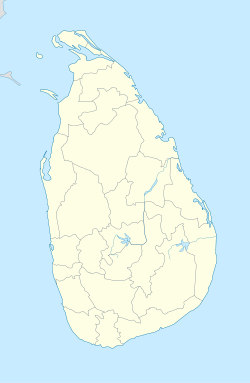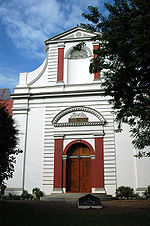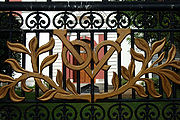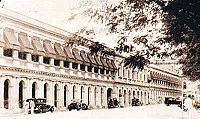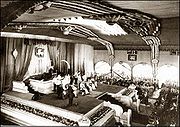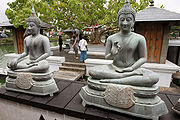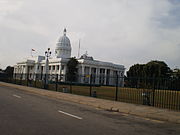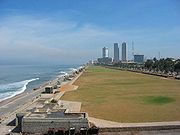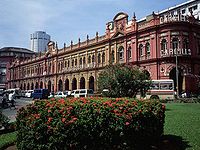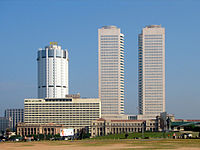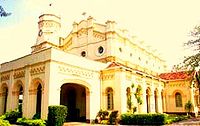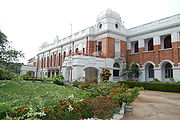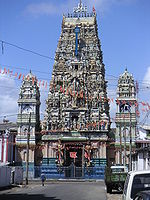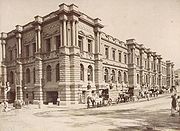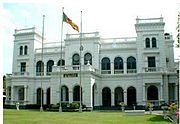
Colombo
Background Information
Arranging a Wikipedia selection for schools in the developing world without internet was an initiative by SOS Children. SOS Children has looked after children in Africa for forty years. Can you help their work in Africa?
| Colombo | |||
|---|---|---|---|
| — City — | |||
| Clockwise from top left: BOC Tower, Colombo Skyline, Colombo Skyline (Gangaramaya Temple), Colombo Skyline (Galle Face), Old Parliament, Colombo Skyline (Gangaramaya Temple), BOC Tower and WTC Twin Tower, Independence Square, WTC Twin Tower | |||
|
|||
| Map of Colombo showing its administrative districts. | |||
|
|
|||
| Coordinates: 6°56′04″N 79°50′34″E | |||
| Country | Sri Lanka | ||
| Province | Western Province | ||
| District | Colombo District | ||
| Government | |||
| • Municipal Council | Colombo Municipal Council | ||
| • Mayor | Uvais Mohamed Imitiyas | ||
| • Deputy Mayor | S. Rajendran | ||
| • Headquarters | Town Hall | ||
| Area | |||
| • City | 37.31 km2 (14.4 sq mi) | ||
| Population (2001) | |||
| • City | 647,100 | ||
| • Density | 17,344/km2 (44,920/sq mi) | ||
| • Metro | 5,648,000 (2,006) | ||
| Time zone | Sri Lanka Standard Time Zone ( UTC+5:30) | ||
| Website | www.cmc.lk | ||
Colombo ( Sinhala: කොළඹ, pronounced [ˈkoləmbə]; Tamil: கொழும்பு) is the largest city and former capital of Sri Lanka. It is located on the west coast of the island and adjacent to Sri Jayawardenapura Kotte, the capital. Colombo is a busy and vibrant city with a mixture of modern life and colonial buildings and ruins and a city population of 647,100. The Colombo Metropolitan Region, defined by the districts of Colombo, Gampaha and Kalutara, has an estimated population of 5,648,000, and covers an area of 3,694.20 km².
Due to its large harbour and its strategic position along the East-West sea trade routes, Colombo was known to ancient traders 2,000 years ago. However it was only made the capital of the island when Sri Lanka was ceded to the British Empire in 1815, and its status as capital was retained when the nation became independent in 1948. In 1978, when administrative functions were moved to Sri Jayawardenepura Kotte, Colombo was designated as the commercial capital of Sri Lanka.
Like many cities, Colombo's urban area extends well beyond the boundaries of a single local authority, encompassing other Municipal and Urban Councils. The main city is home to a majority of Sri Lanka's corporate offices, restaurants and entertainment venues. Famous landmarks in Colombo include the Galle Face Green, the Viharamahadevi Park as well as the National Museum.
Etymology
The name "Colombo", first introduced by the Portuguese in 1505, is believed to be derived from the classical Sinhalese name කොලොන් ථොට Kolon thota, meaning "port on the river Kelani". It has also been suggested that the name may be derived from the Sinhalese name කොල-අම්බ-තොට Kola-amba-thota which means "Harbour with leafy mango trees". However, it is also possible that the Portuguese named the city after Christopher Columbus, the Italian sailor who lived in Portugal for many years before discovering the Americas on behalf of the Spanish monarchs Ferdinand II of Aragon and Isabella I of Castile. His Portuguese name is Cristóvão Colombo. Colombo set sail westwards to look for India around the same time Portuguese sailor Vasco da Gama set sail eastwards, landing at the Port of Calicut in India on 20 May 1498. Colombo discovered the Americas six years before that on 12 October 1492 and was already a famed sailor and explorer, celebrated both in Portugal and Spain by the time Dom Lourenço de Almeida accidentally landed in the port of Galle in 1505.
History
As Colombo possesses a natural harbour, it was known to Romans, Arabs, and Chinese traders over 2,000 years ago. Traveller Ibn Batuta who visited the island in the 14th century, referred to it as Kalanpu. Arab Muslims whose prime interests were trade, began to settle in Colombo around the 8th century AD mostly because the port helped their business and controlled much of the trade between the Sinhalese kingdoms and the outside world. Their descendants now comprise the local Sri Lankan Moor community.
The Portuguese Era
Portuguese explorers led by Dom Lourenço de Almeida first arrived in Sri Lanka in 1505. During their initial visit they made a treaty with the King of Kotte Parakramabahu VIII (1484–1508) enabling them to trade in the islands' crop of cinnamon, which lay along the coastal areas of the island, including in Colombo. As part of the treaty, the Portuguese were given full authority over the coast line in exchange for the promise of guarding the coast against invaders. They were also allowed to establish a trading post in Colombo. Within a short time, however, they then expelled the Muslim inhabitants of Colombo and began to build a fort there in 1517.
The Portuguese soon realized that control of Sri Lanka was necessary for protection of their coastal establishments in India and they began to manipulate the rulers of the Kotte Kingdom in order to gain control of the area. After skilfully exploiting rivalries within the Royal Family, they took control of a large area of the Kingdom and the Sinhalese King Mayadunne established a new Kingdom at Sitawaka, a domain in the Kotte kingdom. Before long he annexed much of the Kotte kingdom and forced the Portuguese to retreat to Colombo, which was repeatedly besieged by Mayadunne and the later Kings of Sitawaka, forcing them to seek reinforcement from their major base in Goa, India. However, following the fall of the Kingdom in 1593, the Portuguese were able to establish complete control over the entire coastal area, with Colombo as their capital.
This part of Colombo is still known as Fort and houses the presidential palace and the majority of Colombo's five star hotels. The area immediately outside Fort is known as Pettah (Sinhala පිට කොවුට piṭa koṭuva, "outer fort") and is a commercial hub.
The Dutch Era
In 1638 the Dutch signed a treaty with King Rajasinha II of Kandy which assured the king assistance in his war against the Portuguese in exchange for a monopoly of the island's major trade goods. The Portuguese resisted the Dutch and the Kandyans, but were gradually defeated in their strongholds beginning in 1639. The Dutch captured Colombo in 1656 after an epic siege, at the end of which a mere 93 Portuguese survivors were given safe conduct out of the fort. Although the Dutch initially restored the captured area back to the Sinhalese Kings, they later refused to turn them over and gained control over the island's richest cinnamon lands including Colombo which then served as the capital of the Dutch maritime provinces under the control of the Dutch East India Company until 1796.
The British era
Although the British captured Colombo in 1796, it remained a British military outpost until the Kandyan Kingdom was ceded to them in 1815 and they made Colombo the capital of their newly created crown colony of Ceylon. Unlike the Portuguese and Dutch before them, whose primary use of Colombo was as a military fort, the British began constructing houses and other civilian structures around the fort, giving rise to the current City of Colombo.
Initially, they placed the administration of the city under a "Collector", and John Macdowell of the Madras Service was the first to hold the office. Then, in 1833, the Government Agent of the Western Province was charged with the administration of the city. Centuries of colonial rule had meant a decline of indigenous administration of Colombo, and in 1865 the British conceived a Municipal Council as a means of training the local population in self-governance. The Legislative Council of Ceylon constituted the Colombo Municipal Council in 1865 and the Council met for the first time on the January 16, 1866. At the time, the population of the region was around 80,000.
During the time they were in control of the Colombo, the British were responsible for much of the planning of the present city. In some parts of the city tram car tracks and granite flooring laid during the era are still visible today.
Post Independence
This era of colonialism ended peacefully in 1948 when Ceylon gained independence from Britain. Due to the tremendous impact this caused on the city's inhabitants and on the country as a whole, the changes that resulted at the end of the colonial period were drastic. An entire new culture took root. Changes in laws and customs, clothing styles, religions and proper names were a significant result of the colonial era. These cultural changes were followed by the strengthening of the island's economy. Even today, the influence of the Portuguese, the Dutch and the British is clearly visible in Colombo's architecture, names, clothing, food, language and attitudes. Buildings from all three eras stand in their glory as reminders of the turbulent past of Colombo. The city and its people show an interesting mix of European clothing and lifestyles together with local customs.
Historically, Colombo referred to the area around the Fort and Pettah Market which is famous for the variety of products available as well as the Khan Clock Tower, a local landmark. At present, it refers to the city limits of the Colombo Municipal Council. More often, the name is used for the Conurbation known as Greater Colombo, which encompasses several Municipal councils including Kotte, Dehiwela and Colombo.
Although Colombo lost its status as the capital of Sri Lanka in the 1980s, it continues to be the island's commercial centre. Despite the official capital of Sri Lanka moving to the adjacent Sri Jayawardanapura Kotte, most countries still maintain their diplomatic missions in Colombo.
Geography and climate
Colombo's geography is a mix of land and water. The city has many canals and, in the heart of the city, the 65- hectare (160- acre) Beira Lake. The lake is one of the most distinctive landmarks of Colombo, and was used for centuries by colonists to defend the city. It remains a popular attraction, hosting regattas, and theatrical events on its shores. The Northern and North-Eastern border of the city of Colombo is formed by the Kelani River, which meets the sea in a part of the city known as the Modera (mōdara in Sinhala) which means river delta.
Colombo features a tropical rainforest climate under the Köppen climate classification. Colombo's climate is fairly temperate all throughout the year. From March to April the temperature averages around 31 degrees Celsius (88 degrees Fahrenheit) maximum. The only major change in the Colombo weather occurs during the monsoon seasons from May to August and October to January. This is the time of year where heavy rains can be expected. Colombo sees little relative diurnal range of temperature, although this is more marked in the drier winter months, where minimum temperatures average 22 degrees Celsius (72 degrees Fahrenheit). Rainfall in the city averages around 2,400 millimetres (94 in) a year.
| Climate data for Colombo, Sri Lanka | |||||||||||||
|---|---|---|---|---|---|---|---|---|---|---|---|---|---|
| Month | Jan | Feb | Mar | Apr | May | Jun | Jul | Aug | Sep | Oct | Nov | Dec | Year |
| Average high °C (°F) | 30 (86) |
31 (87) |
31 (88) |
31 (88) |
31 (87) |
30 (86) |
29 (85) |
29 (85) |
29 (85) |
29 (85) |
29 (85) |
30 (86) |
30 (86) |
| Average low °C (°F) | 23 (74) |
24 (76) |
26 (78) |
26 (79) |
27 (80) |
27 (80) |
27 (80) |
26 (79) |
26 (79) |
26 (78) |
25 (77) |
24 (76) |
26 (78) |
| Precipitation mm (inches) | 83.8 (3.3) |
63.5 (2.5) |
114.3 (4.5) |
254 (10) |
335.3 (13.2) |
190.5 (7.5) |
129.5 (5.1) |
96.5 (3.8) |
157.5 (6.2) |
353.1 (13.9) |
307.3 (12.1) |
152.4 (6) |
2237.7 (88.1) |
| Source: | |||||||||||||
Demographics
Colombo is a multi-ethnic, multi-cultural city. The population of Colombo is a mix of numerous ethnic groups, mainly Sinhalese, Moors and Tamils. There are also small communities of people with Chinese, Portuguese, Dutch, Malay and Indian origins living in the city, as well as numerous European expatriates. Colombo is the most populous city in Sri Lanka, with 642,163 people living within the city limits. According to the census of 2001 the demographics of urban Colombo by ethnicity is as follows.
| No | Ethnicity | Population | % Of Total |
|---|---|---|---|
| 1 | Sinhalese | 265,657 | 41.36 |
| 2 | Tamils | 185,672 | 28.91 |
| 3 | Moors | 153,299 | 23.87 |
| 4 | Indian Tamils | 13,968 | 2.17 |
| 5 | Malay | 11,149 | 1.73 |
| 6 | Burghers | 5,273 | 0.82 |
| 7 | Sri Lankan Chetty | 740 | 0.11 |
| 8 | Bharatha | 471 | 0.07 |
| 9 | Other | 5,934 | 0.96 |
| 10 | Total | 642,163 | 100 |
Government and politics
Local Government
Colombo is a charter city, with a Mayor Council form of government. Colombo's mayor and the council members are elected through local government elections held once in five years. For the past 50 years the city had been ruled by the United National Party (UNP), a right leaning party, whose business friendly policies resonate with the population of Colombo. However the UNP nomination list for the 2006 Municipal elections was rejected, and an Independent Group supported by the UNP won the elections. Uvais Mohamed Imitiyas was subsequently appointed Mayor of Colombo.
The city government provides sewer, road management and waste management services, in case of water, electricity and telephone utility services the council liaises with the water supply and drainage board, the Ceylon electricity board and telephone service providers.
- Official vision and mission
Vision:
| “ | Colombo being a model city in Asia, a caring organization looking after interests of citizens and users with an efficient quality service for creation of safe, healthy and wealthy life. | ” |
Mission
| “ | Organization achieving excellence in providing citizen centred services to the public / customer, optimizing the use of available resources through a competent, motivated and dedicated team. | ” |
National capital
Colombo was the capital of the coastal areas controlled by the Portuguese, Dutch and the British from the 1700s to the 1815 when the British gained control of the entire island following the Kandian convention. From then until the 1980s the national capital of the island was Colombo. During the 1980s plans were made to move the administrative capital to Sri Jayawardenepura Kotte and thus move all governmental institutions out of Colombo to make way for commercial activities. As a primary step the Parliament was moved to a new complex in Kotte and several ministries and departments were also moved. However the move was never completed. Today many governmental institutions still remain in Colombo. These include the President's House, Presidential Secretariat, Prime Minister's House (Temple Trees), Prime Minister's Office, the Supreme Court of Sri Lanka, Central Bank of Sri Lanka, important government ministries and departments; such as Finance (Treasury), Defence, Public Administration & Home affairs, Foreign affairs, Justice and the Military headquarters, Naval headquarters ( SLNS Parakrama), Air Force headquarters ( SLAF Colombo) and Police national and field force headquarters.
Suburbs
Colombo is divided into 15 numbered areas for the purposes of postal services. Within these areas are the suburbs with their corresponding post office.
| Postal zones | Suburbs |
| Colombo 1 | Fort (Colombo) |
| Colombo 2 | Slave Island and Union Place |
| Colombo 3 | Kollupitiya |
| Colombo 4 | Bambalapitiya |
| Colombo 5 | Havelock Town and Kirilapone |
| Colombo 6 | Wellawatte and Pamankada |
| Colombo 7 | Cinnamon Gardens |
| Colombo 8 | Borella |
| Colombo 9 | Dematagoda |
| Colombo 10 | Maradana and Panchikawatte |
| Colombo 11 | Pettah |
| Colombo 12 | Hultsdorf |
| Colombo 13 | Kotahena and Bloemendhal |
| Colombo 14 | Grandpass |
| Colombo 15 | Mutwal, Modera, Mattakkuliya and Madampitiya |
Economy
The great majority of Sri Lankan corporations have their head offices in Colombo. Some of the industries include chemicals, textiles, glass, cement, leather goods, furniture, and jewellery. In the city centre is located South Asia's second tallest building - The World Trade Centre. The 40 story Twin Tower complex is the centre of important commercial establishments, situated in the Fort district, the city's nerve centre. Right outside the Fort area is Pettah which is derived from the Sinhalese word pita which means out or outside as it is outside the Fort.
Pettah is more crowded than the fort area. Pettah's roads are always packed and pavements are full of small stalls selling from delicious Sherbat to Shirts. Main Street consists mostly of clothes shops and the cross roads, which are literally known as Cross Streets where each of the five streets specializes in a specific business. For example the First Cross Street is mostly electronic goods shops, the Second, cellular phones and fancy goods. Most of these businesses in Pettah are dominated by Muslim traders. At the end of the main street further away from Fort is the Sea Street, Sri Lanka's Gold market - dominated by Tamil interests. This mile-long street is full of jewellery shops.
The Colombo Metropolitan Region (CMR) encompasses the country's administrative capital Kotte and Colombo. Found within the borders of the CMR is 80% of the country's industries and over 60% of all vehicles plying Sri Lankan roads.
At one time Air Lanka (now SriLankan Airlines) had its head office in Colombo.
Law enforcement & crime
The Sri Lanka Police the main law enforcement agency of the island liaise with the municipal council, but is under the control of the Ministry of Defence of the central government. Policing in Colombo and its suburbs falls within the Metropolitan Range headed by the Deputy Inspector General of Police (Metropolitan), this also includes the Colombo Crime Division. As with most Sri Lankan cities, the magistrate court handles felony crimes, the district court handles civil cases.
As in other large cities around the world, Colombo experiences certain levels of street crime and bribery. In addition, in From the 1980s to 2009 there have been a number of major terrorist attacks. The LTTE has been linked to most of the bombings and assassinations in the city. Welikada Prison is situated in Colombo and it is one of the largest maximum-security prisons in the country.
Infrastructure
Colombo has most of the amenities that a modern city has. Compared to other parts of the country, Colombo has the highest degree of infrastructure. Electricity, water and transport to street lamps, phone booths and etc. have a considerably good standard. The majority of the major shopping malls in Sri Lanka are located in the city, of which all are wi-fi enabled. Apart from that, many luxurious hotels, clubs and restaurants are also situated in the city. In recent times there's been an outpour of high rise condominiums in the city, mainly due to the very high land prices.
Port of Colombo
The largest and one of the busiest ports in Sri Lanka, the Colombo Harbour is located in this city. Colombo was established primarily as a port city during the colonial era, with an artificial harbour that has been expanded over the years. The Sri Lanka Navy maintains a naval base, SLNS Rangalla within the harbour.
The Port of Colombo handled 3.75 million twenty-foot equivalent units in 2008, 10.6% up on 2007 (which itself was 9.7% up on 2006), bucking the global economic trend. Of those, 817,000 were local shipments with the rest transshipments. The port is close to its capacity for container handling. An expansion project, the South Harbour project, will increase the port's capacity.
Transport
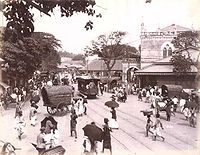
Colombo has an extensive public transport system based on buses. The bus service is operated both by private operators and the government owned Sri Lanka Transport Board (SLTB). Train transport within the city is limited since most trains are meant for transport to and from the city rather than within the city and are often overcrowded. However the Central Bus Stand and Fort Railway Station functions as the islands primary hub for bus and rail transport respectively. Up until the 1970s the city had a trams service, which was discontinued. Other means of transport includes auto rickshaws (commonly called "three wheelers" in Sri Lanka) and taxicabs. Three wheelers are entirely operated by individuals and hardly regulated whilst cab services are run by private companies and are metered.
Construction of the Colombo Metro Rail, a Mass Rapid Transit railway system, similar to that of other advanced Asian cities has begun. The project was established to control the excessive traffic in the city. The project is carried out by NEB Rapid Infrastructure Projects Pvt.Ltd., an Indian and Singaporean collaboration.
Bandaranaike International Airport serves the city for all International flights while the Ratmalana Airport serves all local flights.
- Roads
- A1 highway connects Colombo with Kandy.
- A2 highway connects Colombo with Galle.
- Rail
- Main Line – Colombo to Badulla.
- Southern Line – Colombo to Matara
- Northern Line – Colombo to Kankesanturai deviates from the Main Line at Polgahawela junction - presently operating only up to Vavuniya
- Puttalam Line – Colombo to Puttalam
- Kelani Valley Line (Narrow Gauge)now this is broad gauge - Colombo to Yatiyantota - presently operating only up to Avissawella
- Mannar Line (Earlier Indo-Lanka Line) Colombo To Talaimannar - Divides from Northern Line at Medawachchiya junction - Not operational
Landmarks
The two World Trade Centre towers used to be the most recognized landmarks of the city. Before these towers were completed in 1997, the adjacent Bank of Ceylon tower was the tallest structure and the most prominent landmark of the city. Before the skyscrapers were built it was the Old Parliament Building that stood majestically in the Fort district with the Old Colombo Lighthouse situated close to it. Another important landmark of the city is the Independence Hall at Independence Square in Cinnamon Gardens.
Even before the parliament was built some claim that the Jami Ul-Alfar Mosque was recognized as the landmark of Colombo by sailors approaching the port. The mosque is still one of the most visited tourist sites in Colombo.
Another landmark is St.Paul's Church Milagiriya, one of the oldest churches in Sri Lanka, first built by the Portuguese and re-built by the British in 1848.
The Fort district also has the famous Cargills & Millers complex that is protected by a special government law from demolition. This is done mainly to preserve the historic beauty of the Fort area.
The Galle Face Green is the city's largest and most elegant promenade. Lined with palm trees and adjacent to the coast, this mile-long stretch in the heart of the city is a constant beehive of activity. The green is especially busy on Fridays and Saturdays. In the evenings it plays host to families and children playing sports and flying kites, lovers embracing under umbrellas and health enthusiasts taking their daily evening walks. There are numerous small food stalls and a small stretch of beach to get wet. The green was recently given a make over and since then has been even more popular with the local community. The Green also frequently hosts numerous international and local concerts and performances, such as the recently concluded World Drum Festival.
Cannons that were once mounted on the rampart of the old fort of Colombo laid out for observance and prestige at the Green, giving a colonial touch to the city. The famous colonial styled Galle Face Hotel, known as Asia's Emerald on the Green since 1864, is also adjacent to Galle Face Green. The Hotel has played host to distinguished guests including the British Royal Family and other Royal Guests and Celebrities. Apparently after having stayed at the hotel, Princess Alexandra of Denmark had commented that "the peacefulness and generosity encountered at the Galle Face Hotel cannot be matched". Around the corner from Galle Face are prominent coffee bars, chic bars and boutiques.
Education
Education institutions in Colombo have a long history. Colombo has many of the prominent public schools in the country, some of them government owned and others private. Most of the prominent schools in the city date back to the 1800s when they were established during the British colonial rule, such as the Royal College Colombo (1835). Certain urban schools of Sri Lanka have some religious alignment, this is partly due to the influence of British who established Christian missionary schools, these include the Anglican, Bishop's College(1875); the Buddhist, Ananda College (1886); the Muslim, Zahira College (1892); the Catholic, St. Joseph's College (1896). These religious alignments do not affect the curriculum of the school except for the demographics of the student population.
Higher education in the city has a long history, beginning with the establishment of the Colombo Medical College (1870), the Colombo Law College (1875), School of Agriculture (1884) and the Government Technical College (1893). The first step in the creation of a University in Colombo was taken in 1913 with the establishment of the University College Colombo which prepared students for the external examinations of the University of London, this was followed by the establishment of the University of Ceylon in Colombo. Today the University of Colombo and the University of the Visual & Performing Arts are state universities in the city. The Sri Lanka Institute of Information Technology also has a metropolitan campus in the centre of the city. There are several private higher education institutions within the city.
Architecture
Colombo has wildly varying architecture that span centuries and depict various styles. Many colonial buildings influenced by the Portuguese, Dutch and British exist alongside structures built in Buddhist, Hindu, Islamic, Indian and Contemporary architectural styles. No other place is this more evident in the heart of the city the Fort area. Here one may find new towering skyscrapers as well as historic buildings dating far back as the 1700s.
Colombo Fort
The Portuguese were the first colonist to settle in Colombo, establishing a small trading post they had laid the foundations for a small fort which in time became the largest colonial fort in the island. The Dutch expanded the fort thus creating a well old fortified harbour. This came in to the possession of the British in the late 1700s and by the late 19th century the seeing no threat to the Colombo Harbour, began demolishing the ramparts to make way for the development of the city. Although now there is nothing left of the fortifications the area which was once the fort is still referred to as Fort and the area out side the fort; Pettah or pita-koutuwa in Sinhalese which means outer fort.
Dutch era buildings
There are none of the buildings of the Portuguese era and only a few from the Dutch period. These include the oldest building in the fort area, the Dutch Hospital, the Dutch House which is now the Colombo Dutch Museum and several churches. The President's House (formerly the Queen's House) have originally been the Dutch governor's house, and successive British Governors made it their office and residence. However, it has undergone much change since the Dutch period. Adjoining the President's House are the Gordon Gardens, now off limits to the public.
British era buildings
Much of the old buildings of the fort area and in other parts of the city date back to the British times, these include governmental, commercial buildings and private houses. Some of the notable government building of British colonial architecture includes; the old Parliament building which is now the Presidential Secretariat, the Republic Building which houses the Ministry of Foreign affairs, but once housed the Ceylon Legislative council, the General Treasury Building, the old General Post Office an Edwardian style building opposite the President's House, the Prime Minister's Office, the Central Telegraph Office, the Mathematics department of the University of Colombo (formally the Royal College, Colombo). Notable commercial buildings of the British era include, the Galle Face Hotel, Cargills & Millers complex, Grand Oriental Hotel.
Culture
Annual cultural events and fairs
Colombo's most beautiful festival is the celebration of Buddha's Birth, Enlightenment and Death all falling on the same day. In Sinhala this is known as Vesak. During this festival, much of the city is decorated with lanterns, lights and special displays of light(known as Thoran). The festival falls in mid May and lasts a week when many Sri Lankans visit the city to see the lantern competitions and decorations. During this week people distribute, rice, drinks and various other food items for free in places what is known as Dunsal which means charity place. These Dunsal are popular amongst visitors from the suburbs.
Christmas is another major festival in the city. Although Sri Lanka's Christians make up only just over 7% of the population, Christmas is one of the island's biggest festivals. Most streets and commercial buildings light up from the beginning of December and festive sales begin at all shopping centres and department stores. Caroling and nativity plays are also frequent sights during the season.
The 'sinhala Hindu aluth awurudda' is another cultural event that takes place in April. This is the celebration of the Sinhala and Hindu new year. The festivities take place on 13 and 14 April and include many events and traditions that display a great deal of Sri Lankan culture.
Several old clubs of the city gives a glimpse of the British equestrian life style, these include the Colombo Club, Orient Club, the 80's Club, the Colombo Cricket Club.
Performing arts
Colombo has several performing arts centers which are popular for their musical and theatrical performances. The most famous performing arts centers are the Lionel Wendt Theatre, the Elphinstone and the Tower Hall, all of which have a very rich history and made for western style productions. The Navarangahala also found in the city is the country's first national theatre designed and build for Asiatic and local style musical and theatrical productions.
Museums and art collections
The National Museum of Colombo, was established on 1 January 1877 during the tenure of the British Colonial Governor Sir William Henry Gregory is situated in cinnamon gardens area. The museum houses the crown jewels and throne of the last king of the Kingdom of Kandy, Sri Vikrama Rajasinha. There is also the Colombo Dutch Museum detailing the Dutch colonial history of the country. Colombo does not boast a very big art gallery. There is a small collection of Sri Lankan masterpieces at the Art Gallery in Green Path next to it is the Natural History Museum.
Sports
Undoubtedly the most popular sport in Sri Lanka is cricket. The country emerged as champions of the 1996 Cricket World Cup and became runners up in 2007. In the most recent tournament, the ICC World Twenty20 2009 they became runners up again. The sport is played in parks, playgrounds, beaches and even in the streets of the city. Colombo is also the home for two of the country's international cricket stadiums, Sinhalese Sports Club's cricket stadium and R. Premadasa Stadium (named after late president Premadasa). Rugby is also a popular sport at the club and school level. Colombo has the distinction of being the only city in the world to have 4 cricket Test venues in the past: Paikiasothy Saravanamuttu Stadium, Sinhalese Sports Club Ground, Colombo Cricket Club Ground and Ranasinghe Premadasa Stadium. The Sugathadasa Stadium situated in the city, is an international standard stadium for athletics, swimming and football, also held the South Asian Games in 1991 and 2006. Situated in Colombo the Royal Colombo Golf Club is one of the oldest Golf Clubs in a Asia. Other sporting clubs in Colombo include Colombo Swimming Club, Colombo Rowing Club and the Yachting Association of Sri Lanka.
The city of Colombo also has its own local football team Colombo FC and the sport is being developed as a part of the FIFA Goal program.
Sister cities
| Country | City | State / Region | Since |
|---|---|---|---|
| 2003 | |||
| 1997 | |||
| |



